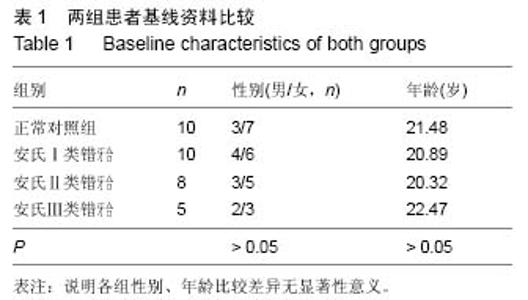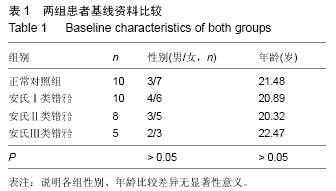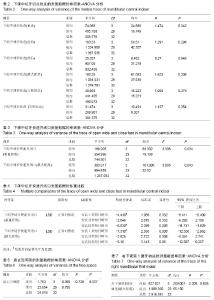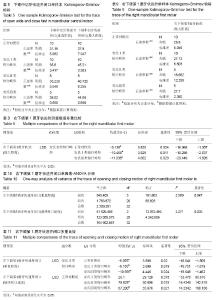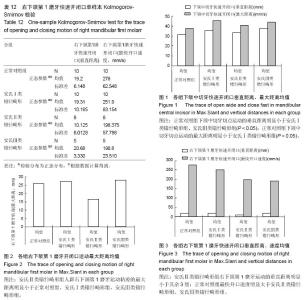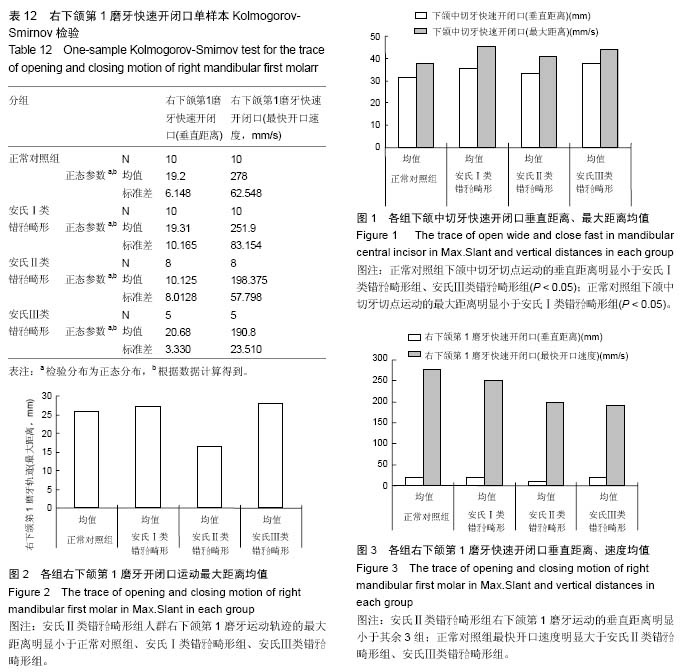| [1] 徐可卿,王舰英.下领运动轨迹描记仪在口腔医学中的应用[J].国外医学口腔医学分册,1993,20(6):351-354.
[2] 王美青.口腔解剖生理学[M].北京:人民卫生出版社, 2012: 79-85.
[3] 苏剑生,林氢伟,郑光榕.正常牙合青少年下颌切点边缘运动轨迹的定量分析[J].口腔医学,1996,6(4):177-178.
[4] 冯静,周力,吕涛.恒牙列早期安氏Ⅲ类错牙合患者下颌边缘运动轨迹的研究[J].华西口腔医学杂志,2005,23(06): 508-511.
[5] 杨四维,赵美英.正常牙合及安氏Ⅱ类1分类错牙合下颌运动的研究[J].华西口腔医学杂志,1992,10(1):37-41.
[6] 唐成忠,彭适生.恒牙初期前牙反(牙合)治疗前后不颌运动轨迹的研究[J].上海口腔医学,1998,7(1):17-21.
[7] 李楠,李新,毕良佳.颞下颌紊乱病与(牙合)因素关系的研究进展[J].口腔医学研究,2012,28(2):185-187.
[8] 谢荣敏,秦朴,杜跃华. 安氏Ⅱ2伴单侧颞下颌关节弹响患者正畸治疗的疗效分析[J]. 第三军医大学学报,2009, 31(10):970-973.
[9] 丁寅.正畸治疗中颞下颌关节紊乱病风险及其防治策略[J].中国实用口腔科杂志,2013,6(5):27-260.
[10] 孙志鹏,邹冰爽,赵燕平,等.口腔正畸患者颞下颌关节骨关节病的临床分析[J].北京大学学报(医学版),2008,40(1): 47-51.
[11] 杨增龙,何通文,王戎,等. 口腔正畸治疗与颞下颌关节疾病相关性的研究进展[J]. 甘肃医药,2014,33(2):111-113.
[12] 王启明,方泽强,冯驰. 偏侧咀嚼与颞下颌关节紊乱病的相关性研究[J]. 激光杂志,2014,35(5):85-87.
[13] 王晓宇,厉松.安氏Ⅱ~1青少年髁突运动轨迹与颞下颌关节形态的研究[J].北京口腔医学,2011,19(3):164-166.
[14] 王辉,毕振宇,赵卫东,等.运动捕捉技术对下颌开闭运动的数字化采集及分析[J].南方医科大学学报,2011,31(09): 1597-1599.
[15] Lewis RP, Buschang PH, Throckmorton GS. Sex differences in mandibular movements during opening and closing. American journal of orthodontics and dentofacial orthopedics : official publication of the American Association of Orthodontists, its constituent societies, and the American Board of Orthodontics. 2001;120(3):294-303.
[16] Neill DJ, Howell PG. Kinesiograph studies of jaw movement using the Commodore Pet microcomputer for data storage and analysis. Journal of dentistry. 1984;12(1):53-61.
[17] Kang JH, Chung SC, Fricton JR. Normal movements of mandible at the mandibular incisor. The Journal of prosthetic dentistry. 1991;66(5):687-92.
[18] Mohl ND, McCall WD, Jr.,et al. Devices for the diagnosis and treatment of temporomandibular disorders. Part I: Introduction, scientific evidence, and jaw tracking. The Journal of prosthetic dentistry. 1990; 63(2):198-201.
[19] Hirsch C, John MT, Lautenschlager C,et al. Mandibular jaw movement capacity in 10-17-yr-old children and adolescents: normative values and the influence of gender, age, and temporomandibular disorders. Eur J Oral Sci. 2006;114(6):465-470.
[20] 王辉,刘阳,赵卫东,等.下颌开闭口运动的三维数字化虚拟还原[J]. 中国临床解剖学杂志,2011,29(05):568-571.
[21] 许妍,杨晓江,高晓辉. 成人骨性Ⅲ类错牙合患者咀嚼时下颌运动特点的研究[J].北京口腔医学,2009,17(6):321-323.
[22] Gomes SG, Custodio W, Faot F,et al. Masticatory features, EMG activity and muscle effort of subjects with different facial patterns. J Oral Rehabil. 2010; 37(11):813-9.
[23] Kim DS, Choi SC, Lee SS,et al. Principal direction of inertia for 3D trajectories from patient-specific TMJ movement. Computers in biology and medicine. 2013; 43(3):169-75.
[24] Kim DS, Choi SC, Lee SS, et al. Correlation between 3-dimensional facial morphology and mandibular movement during maximum mouth opening and closing. Oral surgery, oral medicine, oral pathology, oral radiology, and endodontics. 2010;110(5):648-656.
[25] Wen-Ching Ko E, Huang CS, Lo LJ, et al. Longitudinal observation of mandibular motion pattern in patients with skeletal Class III malocclusion subsequent to orthognathic surgery. Journal of oral and maxillofacial surgery : official journal of the American Association of Oral and Maxillofacial Surgeons. 2012;70(2):e158-68.
[26] Ueki K, Marukawa K, Moroi A, et al. Changes in border movement of the mandible in skeletal Class III before and after orthognathic surgery.Int J Oral Maxillofac Surg. 2014;43(2):213-216.
[27] 徐君伍.口腔修复学[M] .北京:人民卫生出版社, 1993.
[28] Travers KH, Buschang PH, Hayasaki H, et al. Associations between incisor and mandibular condylar movements during maximum mouth opening in humans. Arch Oral Biol. 2000;45(4):267-275. |
